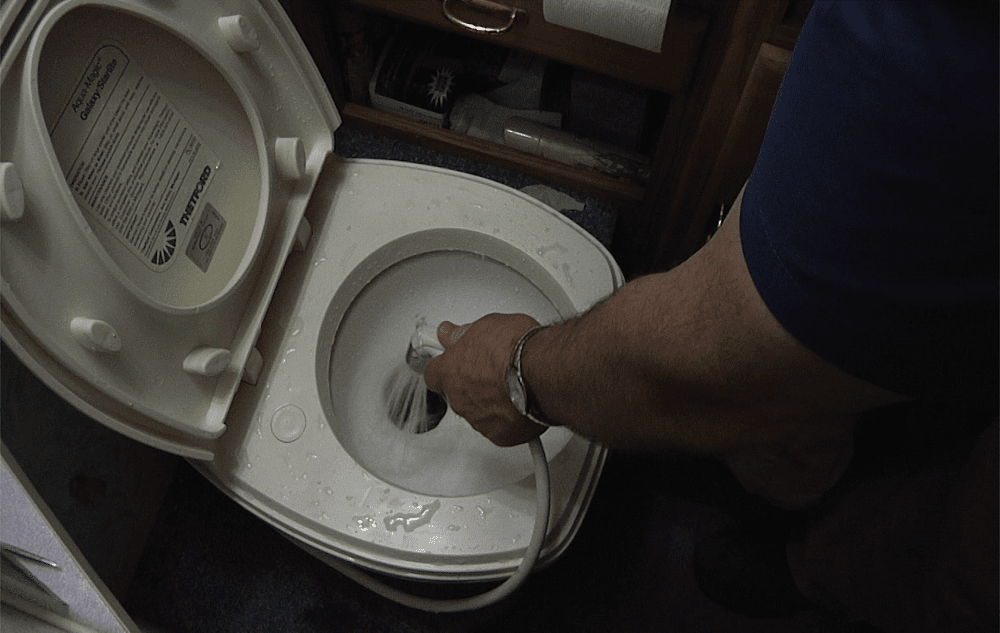When you buy through links on our site, we may earn an affiliate commission, Read More.
Most people when trying to cope with RV life have a common question about how an RV toilet works. Undoubtedly it’s an important aspect of every motorhome. If you have come looking for the answer, this is the right place for you.
RV dwellers are often blessed with the profound freedom of going places and making every adventure come true. But when it comes to nature’s call, often they had to become creative to get the job done. By creative I mean hiding, finding bush, digging holes, and so on.
For that particular reason, toilets for travel trailers came into play. This single-purpose appliance is your only savior when you are on the road traveling. In this article, I will explore all the types of toilets you can get your hands on, how does an RV toilet work along with important facts you should know before buying them.
Let’s get started!
Various Types of Camper Toilets
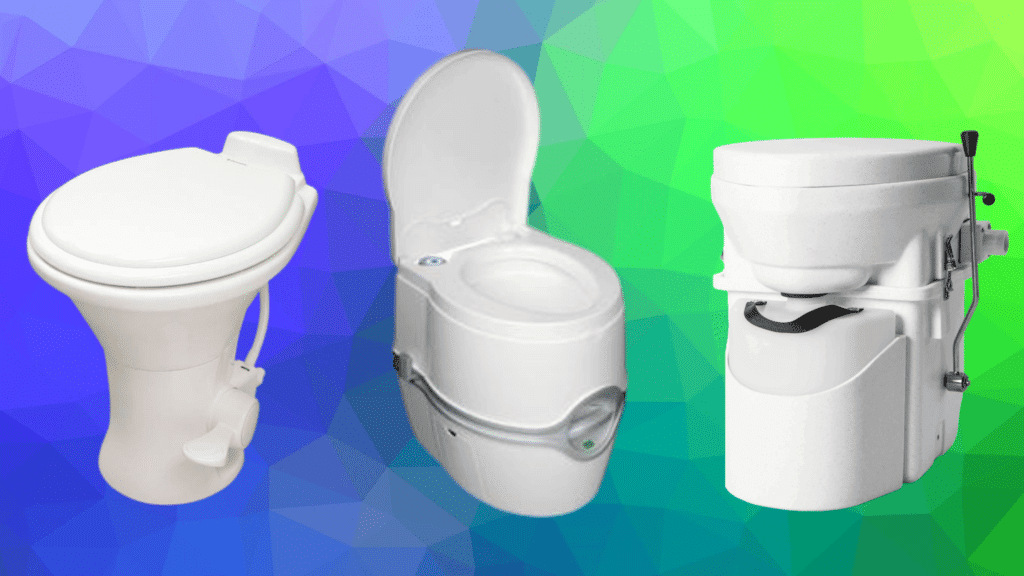
For starters, camper toilets are not the typical toilet you usually found in your house nor do they function the same. To understand how they operate you should get familiar with the types of toilets in the market.
- Traditional Motorhome Toilets
- Portable RV Toilets
- Composting Toilets
- Cassette Toilets
Now that you know the name of the most common RV Toilets, let’s jump into brief details on how each type works.
1. Traditional Motorhome Toilets
These types of toilets are stationary with the camper in a designated place or bathroom. The main reason it’s a stationary toilet is that the unit has a connection with the black tank of the camper. Anything you dump goes straight to the tank underneath including the water.
On the first look, you will realize, there is no water reservation tank on the unit itself and any flush handle. The flash pedal or lever is on the feet level for easy access which pulls water from the fresh water tank. This is the only flush toilet for RV.
How traditional toilets work
The drain pipe on the toilet’s bowl initially stays close when you see it from the above. It opens only after you pull the lever or press the pedal under your feet. Then the water comes down from the fresh water tank and takes your waste to the black tank.
Pro Tip for Traditional Toilets
- Remember to keep a one-quarter amount of water in the bowl before you use it. It will help a lot in doing a cleaner job.
- Always use tissue paper that dissolves quickly so dumping the waste on the RV station would be much easier.
- Try to clean the toilet whenever you have time to spare. Timely cleaning will maintain overall functionality.
2. Portable RV Toilets
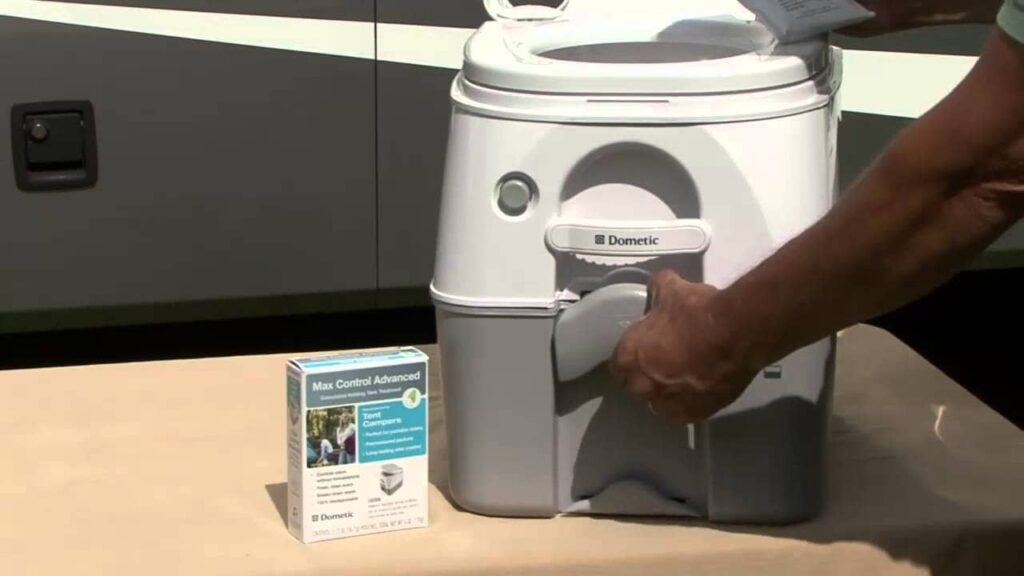
As the name goes, it is exactly what it sounds like. Smaller in size, easy to move, even have the flexibility to use it on the outside. What more do you want in an RV toilet?
That said portable toilets are the most common toilet type you can find in any small RV. For those who have a very tight space in the trailer but still want the option, this is precisely what you want.
This RV toilet with a tank is so much easier to dump and most importantly it requires less water compared to traditional RV toilets.
How Portable RV toilets work
Most portable toilets used in RV look like a small bucket or a drum shape. You will see 2 compartments in this unit. The upper part takes in your waste and water. The lower part is where all these go after you flush.
For tank cleanout, you just have to remove the lower compartment to unload in the RV disposal station.
Pro Tip for Portable RV Toilets
- Depending on the tank size, the frequency of cleanout will vary. So keep track of the next cleaning day in advance.
- As the portable unit is much smaller, try to place this in a secluded area in your trailer. You can also plan for a dedicated space when building an RV.
- Be sure to use deodorant specially made for portable toilets so that your trailer won’t stink down the road.
3. Composting Toilets
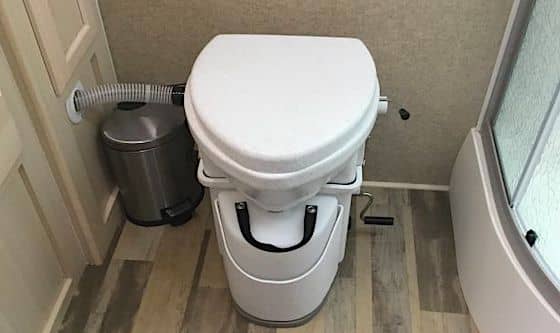
RV composting toilets are widely used in large motorhomes. As the name suggests, this toilet makes compost out of your waste naturally. You just need to add special chemicals or additives.
Unlike other camper toilets, this uses the least amount of water. Once in a while, you will only add a little water to additives. And the great news is, it won’t smell bad.
Pro-tip for composting toilets
- Use vinegar mixed in water to get a better bowl cleaning solution, whenever you feel like it’s getting dirty.
- If it’s started to smell after a few days, try adding some coffee grind to it. It will lower the bad sensation.
- Get your hands on some composting worms and throw them in the holding tank to speed up the process.
4. RV Cassette Toilets
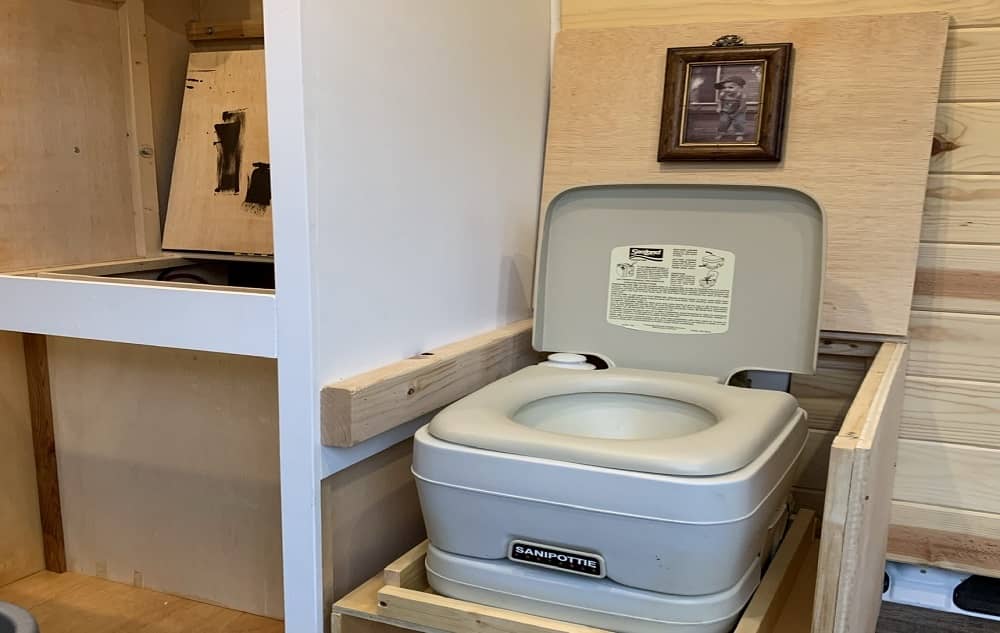
These special types of toilets are for quick use and take up only a small place. If an adventurer wants to make an RV that can stand the need for a toilet without having a bathroom, this is it. The sliding mechanism in this is very handy to access.
Like portable and traditional RV toilets, this also requires a very little amount of your freshwater. It features a dedicated black tank on the back of the toilet which is easily accessible from the outside.
How RV Cassette toilets work
In general, the cassette-type toilets are tucked away in a small compartment out of sight. When it’s time, open the door and pull the unit. After you have finished press flush that will call water from the freshwater tank and the waste goes to the black tank.
Pro-tip for RV Cassette Toilets
- If possible use the cassette toilets for only number one. This will help save space in the septic tank and you can use it longer till the next dumping.
- When using toilet paper, make sure you throw them away in a separate place. This is another great way to save tank space.
- Never skip dumping day. Even though the black tank is not as nearly full, you should empty the tank every 2 days.
RV Toilet System: Basic Diagram
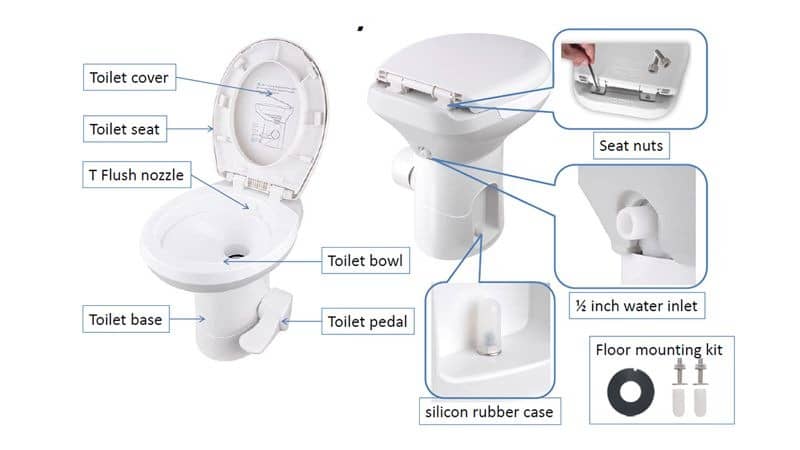
Almost all RV toilet systems with water utilization work in the same way. There is a bowl and then a valve and finally the septic tank or the black tank. The valve and the water in between help to give off a less bad odor through the bowl.
For an easy understanding look at the RV toilet parts diagram.
It’s not that complicated to comprehend what goes where. It’s always a great idea to prime your bowl with a bit of water first. For that there should be an electric switch around, tugging the lever or pressing the pedal for a brief moment also does the same.
This water will aid in emptying the bowl properly withholding fewer particles. Speaking flush, the luxury of water usage is very limited in these toilets. You get to use only the essential amount of water.
That’s because your freshwater tank can’t hold large quantities of water for both general use and toilet use. So keep in mind to use it as efficiently as possible.
Do You Have to Use Special Toilet Paper in an RV?
In short yes. Let me explain why? RV toilet unit is specially designed for use in Camper and the fifth wheel. The whole system doesn’t work like your home toilets. The system has a lot of limitations. Such as smaller tank capacity, frequent tank cleanout, less water usage, and so on.
So when you use traditional house toilet paper it tends to clog your system. In the black tank, toilet paper particles take a long time to dissolve. These are not very pleasant scenarios for an RV toilet. That’s why there are special toilet papers for tackling these situations.
Like your house toilet, RV toilet maintenance is a great thing of importance. The more you take care of the unit, the less problems it will show in the future. Here are some tips to properly maintain your RV toilets.
- Do clean the outside of the toilet on a regular basis. You can use an old cloth and bottle spray if you like.
- For the bowl, you will need a toilet scrubber or any brush you like. Give it a good brush once in a while. Use a good toilet cleaner if it’s possible. Otherwise, you can use vinegar and water.
- To save water, continue scrubbing while flushing. This will clean the brush in the process.
- Regular Check for any leakage. If you see any watermarks or dripping, immediately investigate and try to fix them.
Various RV stations and repair points sometimes offer a quick check-up and fix of your toilet system. If you can spare some money, it would be worth every penny.
Advantages to Composting Toilets
In the RV community, the composting toilets are the most eco-friendly and efficient of all other types. Though some people don’t like the idea of having to be around while your waste is composting. Other than that RV toilets can’t be better than this.
Here are some advantages of composting toilets con to consider.
Easy to install and use
The unit almost looks like a portable toilet. If your RV doesn’t have a dedicated bathroom or has a small interior. This is the right toilet for you. You also won’t need water and a separate black tank for this setup.
Efficient
With a composting toilet, the word efficiency is synonymous with the unit. Why? Because it doesn’t require you to have a huge water tank nor does it use any electricity. The composting process also doesn’t require any extra energy.
Less odor
This is why people like composting toilets so much. One big problem when pooping in your RV toilet is every so often if put out a bad smell. But in the case of composting toilets, the process breaks down your waste and makes natural compost out of it.
No need for a black tank
Another plus point of having a composting toilet is you will not have to install a black tank for your waste. Your unit has its tank to hold and compost your waste. This makes less time spending on cleaning.
Eco-Friendly
The compost made in the toilet is a genuine nutrient for trees. If you like, you can use them in the garden to boost growth. But if you have other plans you can still dispose-off carefree as it won’t harm nature in any way.
Recommended Toilet based on the features
If you want a quick and easy solution to your toilet problem, a portable toilet is the right way to go. Among the numerous portable toilets in the market, the Camco RV toilet seems to gain quite a popularity in terms of features. Which are as follows-
Features
- Large 5.3-gallon holding tank.
- 2.5-gallon flush tank.
- Compact size ideal for any RV.
- Sturdy build materials.
- Intuitive sliding latch.
For a concerned individual who keeps an open eye on what we give back to nature, there is no better option than a composting toilet. Well, it’s good for everyone. Here is the rundown of important features –
Features
- Fast composting with the implication of hand crank.
- Widely used and user-friendly controls.
- Easy to install in any camper.
- Durable molded design
- 5-inch vent hose, strong bottle cap, and 12v power plug
People with large space in the RV have more flexibility to add a Full-Size toilet. Anything less than that would not add any value overall. So when you shop, here is my top selection of full-size Dometic RV toilets. Here are the reasons why?
Features
- Residential style Full-size wooden seat
- 100% guaranteed ceramic bowl
- Hand spray and foot pedal included
- Efficient water use
- Non-spilling rim design
- Gravity flush system
Frequently Asked Questions on RV Toilet
1. Can you poop in a camper toilet?
In all fairness yes, you can. But there is a catch. Make sure no other elements can get into the septic tank. You can use toilet paper but it needs to be a rapidly dissolving one.
2. How do I unclog my camper toilet?
For quick action use a plunger to release any clog in the toilets. For an alternative method use vinegar and a little bit of dishwasher in the drain pipe. It may soften the clog and the plunger will be more effective.
3. Can you use the toilet in an RV while driving?
Technically there are fewer restrictions on how to use the RV toilet while driving. As long as the septic tank is sealed and no chance of spilling on the road, you are good to go.
4. How much water does an RV toilet use per flush?
RV toilet water usage per flush typically depends on the design. For example, since 1994 manufacturers maintain the standard of 1.6 gallons per flush. But there are new models in the market now that use even less than that.
5. How often do you empty a motorhome toilet?
For portable and cassette toilets, it’s a good idea to empty the waste tank once every 2 days or so. Other types of toilets like composting and full-size toilets aren’t needed very often. But it’s a good idea to clean as long you are in the vicinity of an RV station.
6. Why does my RV toilet smell like urine?
This can be happening from leaks around various pipe joints or the seal must have not closed properly. First, check thoroughly for any watermarks or drip stains. Then carefully shut those leaks with pipe sealant. If you are having a hard time diagnosing, contact a professional.
7. Where do I empty my portable toilet?
There is a designated place for emptying your black tank. Such places are in the all campground, RV station, highway pit stop, and vice versa. If any of these are not around you can dig a fairly deep hole and dump it in there. Make sure the hole is properly covered with soil.
8. Why does my RV toilet smell so bad?
The main reason your RV toilet smells so bad is because of leaks. Another common cause can be the culprit of the funky smell which is non-compatible toilet paper. Regular toilet paper tends to jam in pipes and doesn’t degrade as fast as rapidly dissolving toilet paper.
9. What chemicals do you put in a portable toilet?
Portable toilets have a holding tank of their own. So it would be in your good interest if you can manage to put some deodorize in the bowl from time to time. You can find a lot of them in the RV shop or online. The deodorize sometimes contains fragrance and Biocides.
10. How often do you need to dump RV waste?
Depending on the toilet type you have, it widely varies. In the case of traditional toilets, you can hold a couple of days before dumping it in the Camper sight. For smaller options like portable toilets, the ideal duration is 2 days.
11. How does an RV composting toilet work?
The unit has 4 compartments for separate particles. One holds the additives that help with composting. The other two sections are for a bowl and holding reservoir. The reservoir stores all your waste and the additive from the side chamber makes the waste fertilizer naturally.
12. How to use RV toilet Chemicals?
For ease of use, toilet chemicals often come in a spray bottle. If your chemical bottle has no sprayer attachment, buy one from your local shop. In most cases, a couple of spay does the job very well.
Final thoughts
For new people coming into this new lifestyle, how does an RV toilet work can be confusing. But with time it will only get easier.
I hope reading this article you have a clear understanding of the types and how it works in general. Select the best one that suits your needs and keep traveling the world worry-free.

